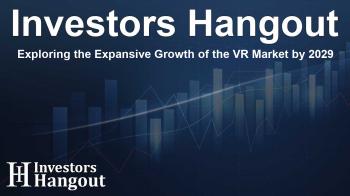Exploring the Expansive Growth of the VR Market by 2029

An In-Depth Look at the Virtual Reality Market Growth
The virtual reality (VR) market is on the brink of explosive growth, with a remarkable increase projected at USD 133.17 billion between 2025 and 2029. According to market analysts, this growth signifies a compound annual growth rate (CAGR) of a staggering 38% during this forecast period. As industries continue to embrace technological advancements, the potential of VR technology remains boundless.
Key Contributors to Market Expansion
One of the most compelling aspects of the VR market is the pivotal role North America plays in its expansion. A projected 33% of the market growth is expected to originate from this region alone. Major tech giants such as Alphabet, Facebook Inc., and Microsoft Corp. are at the forefront of this development, investing heavily in VR technologies. Moreover, consumers are rapidly adopting innovative applications, which further propels the market's growth. The extensive research and development efforts in both the U.S. and Canada solidify North America as a crucial player in the global VR landscape.
Factors Driving Adoption
Several factors account for the swift adoption of VR technology within the North American markets. One substantial contributor is the robust demand for enthralling entertainment experiences. VR gaming, immersive filmmaking, and interactive retail experiences are captivating audiences like never before. Furthermore, industries such as healthcare are harnessing VR for therapeutic interventions and training exercises, demonstrating the practical applications of this technology.
Market Segmentation Insights
The segmentation of the VR market encompasses various categories, including end-users (enterprise vs. consumer), components (hardware vs. software), and geographical locations. Notably, the usefulness of VR extends across multiple sectors—from entertainment and training to healthcare and real estate. This versatility underscores the potential revenue streams that the VR market is expected to tap into over the coming years.
Emerging Technologies within the VR Space
Cutting-edge developments in VR hardware, such as new headset releases and more immersive gloves and suits, are propelling user adoption across different sectors. The healthcare industry is leveraging these innovations to improve diagnostics and treatment; for example, VR is increasingly utilized in mental health therapies and surgical simulations, offering transformative benefits. Furthermore, evolving networking capabilities and digital solutions are enhancing the user experience, fueling further interest and investment in VR technologies.
Potential Challenges in the VR Market
Despite the promising outlook, the VR market faces challenges that could impede its growth trajectory. The rise of augmented reality (AR) presents noteworthy competition, necessitating continuous innovation to stay ahead. Additionally, consumer education on the benefits and user experience provided by VR may take time, but ongoing efforts by companies will aim to bridge this gap.
Future Opportunities and Innovations
As VR technologies continue to evolve, the opportunities for integrating VR into daily life are endless. Companies are exploring applications in virtual travel experiences, educational settings, and enhanced remote working environments. Moreover, the implications of VR extend into collaborative platforms, where individuals can convene in virtual spaces, transforming the way people communicate and collaborate.
Technavio’s Role in Market Research
As a leading global technology research and advisory firm, Technavio specializes in analyzing emerging market trends. Their reports are invaluable for businesses seeking actionable insights to navigate the fast-paced VR market. With a comprehensive portfolio of over 17,000 reports covering a vast array of technologies, Technavio equips enterprises of all sizes to identify market opportunities effectively.
Frequently Asked Questions
What is driving the growth of the VR market?
The growth of the VR market is primarily driven by advancements in technology, increasing consumer demand for immersive experiences across industries, and notable investments from major tech companies.
Which region is expected to lead the VR market?
North America is projected to lead the growth of the VR market, contributing 33% of the global market expansion.
What industries are adopting VR technology?
VR technology is being adopted across various industries, including healthcare, gaming, education, real estate, and entertainment.
How is VR used in healthcare?
In healthcare, VR is utilized for therapeutic applications, training simulations, and enhancing patient diagnostics, providing transformative solutions.
What potential challenges does the VR market face?
Challenges such as competition from augmented reality (AR) technology and the need for consumer education could potentially slow the growth of the VR market.
About The Author
Contact Riley Hayes privately here. Or send an email with ATTN: Riley Hayes as the subject to contact@investorshangout.com.
About Investors Hangout
Investors Hangout is a leading online stock forum for financial discussion and learning, offering a wide range of free tools and resources. It draws in traders of all levels, who exchange market knowledge, investigate trading tactics, and keep an eye on industry developments in real time. Featuring financial articles, stock message boards, quotes, charts, company profiles, and live news updates. Through cooperative learning and a wealth of informational resources, it helps users from novices creating their first portfolios to experts honing their techniques. Join Investors Hangout today: https://investorshangout.com/
The content of this article is based on factual, publicly available information and does not represent legal, financial, or investment advice. Investors Hangout does not offer financial advice, and the author is not a licensed financial advisor. Consult a qualified advisor before making any financial or investment decisions based on this article. This article should not be considered advice to purchase, sell, or hold any securities or other investments. If any of the material provided here is inaccurate, please contact us for corrections.

